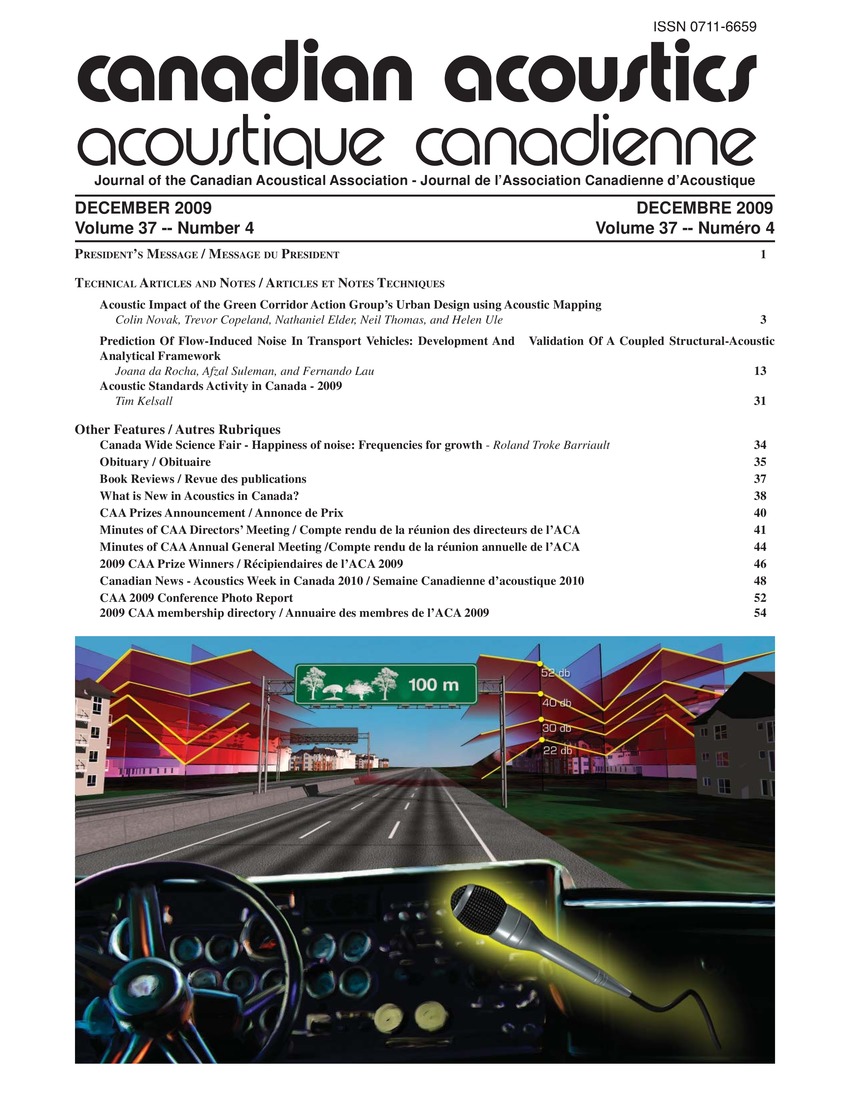Acoustic impact of the green corridor action group's urban design using acoustic mapping
Mots-clés :
Acoustics, Bridges, Noise abatement, Noise pollution, Profitability, Reengineering, Reverse engineering, Acoustic design, Acoustic engineering, Acoustic impacts, Acoustic mapping, Design proposal, Environmental noise, Environmental noise levels, Landscape design, Noise legislation, Noise levels, Not-for-profit organization, Psychological health, Residential areas, Soundscapes, Traffic noise, Urban designRésumé
“Green Corridof’ est une association à but non lucratif qui propose un concept d’espace vert le long de la route qui mène au pond Ambassador, le principal pond international rejoignant le Canada et les Etats-Unis. En plus de vouloir améliorer l’esthétisme de cette route industrielle principalement faite de béton, le groupe « green corridor » souhaite améliorer le paysage sonore du voisinage avec leurs innovants aménagements paysagés. Le haut niveau sonore du trafic routier du quartier vient du fait que cette route est l’un des plus importants couloirs terrestres du commerce dans le monde. Cette étude analyse d’un point de vue acoustique les changements proposés par les actions du groupe « green corridor ». Dans un premier temps l’étude quantifie et modélise les conditions sonores existantes, incluant la mise en œuvre d'un exercice de retro-ingénierie pour assurer une carte acoustique précise. Dans un second temps l’étude est une prédiction des niveaux sonores suite à la mise place du projet de Green Corridor. L’analyse des résultats montrent qu’à certains endroits, le projet de Green Corridor serait efficace pour réduire le niveau sonore mais qu’à d’autres l’impact serait inexistant. Il faudrait alors mettre en œuvre d’autres mesures pour pouvoir arriver à atteindre les objectifs fixés par la province. Une discussion est jointe sur les bénéfices d’une bonne conception acoustique et sur l’amélioration de la législation. Pour finir, l’étude parle des possibles effets sur la santé physique et mentale des résidents des quartiers exposés à de hauts niveaux sonores.Fichiers supplémentaires
Publié-e
Comment citer
Numéro
Rubrique
Licence
Author Licensing Addendum
This Licensing Addendum ("Addendum") is entered into between the undersigned Author(s) and Canadian Acoustics journal published by the Canadian Acoustical Association (hereinafter referred to as the "Publisher"). The Author(s) and the Publisher agree as follows:
-
Retained Rights: The Author(s) retain(s) the following rights:
- The right to reproduce, distribute, and publicly display the Work on the Author's personal website or the website of the Author's institution.
- The right to use the Work in the Author's teaching activities and presentations.
- The right to include the Work in a compilation for the Author's personal use, not for sale.
-
Grant of License: The Author(s) grant(s) to the Publisher a worldwide exclusive license to publish, reproduce, distribute, and display the Work in Canadian Acoustics and any other formats and media deemed appropriate by the Publisher.
-
Attribution: The Publisher agrees to include proper attribution to the Author(s) in all publications and reproductions of the Work.
-
No Conflict: This Addendum is intended to be in harmony with, and not in conflict with, the terms and conditions of the original agreement entered into between the Author(s) and the Publisher.
-
Copyright Clause: Copyright on articles is held by the Author(s). The corresponding Author has the right to grant on behalf of all Authors and does grant on behalf of all Authors, a worldwide exclusive license to the Publisher and its licensees in perpetuity, in all forms, formats, and media (whether known now or created in the future), including but not limited to the rights to publish, reproduce, distribute, display, store, translate, create adaptations, reprints, include within collections, and create summaries, extracts, and/or abstracts of the Contribution.


